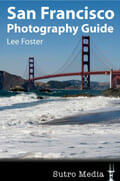
Image: © 2008 Lee Foster. All Rights Reserved.
You may not know Lee Foster‘s name, but I bet you’ve seen his photographs. Lee, who I met at the Bay Area Independent Publishers Association meetings, has published photos in more than 225 Lonely Planet travel guides, and articles in every major travel magazine in the country, winning eight Lowell Thomas Awards in the process. Lee has 10 books in print, all of which are available on his Foster Travel website.
 Recently Lee has been something of a pioneer in moving his most recent two photography/travel books onto the iPhone platform through Apple’s App Store. Partnering with Sutro Media, a developer specializing in real world travel guides on mobile phone platforms.
Recently Lee has been something of a pioneer in moving his most recent two photography/travel books onto the iPhone platform through Apple’s App Store. Partnering with Sutro Media, a developer specializing in real world travel guides on mobile phone platforms.
His San Francisco Photography Guide has really taken off lately. The App combines the photographs and text of his print book with some of the unique capabilities of the mobile iPhone. It links locations where Lee has taken photographs with the phone’s GPS to help you stand in the same spot. It integrates with the iPhone’s mapping function to deliver a lot of location-based information useful for any tourists to the city. It’s a great example of some of the directions in which we’re seeing books stretched by their leap to digital technologies.
Here Lee tells us what happened, and a little more about being in the App Book business.
What’s been happening with your San Francisco App, Lee?
It recently sold 957 units in a month, 5-20-10 to 6-20-10. The app is San Francisco Travel and Photo Guide (Sutro Media, $1.99) in the Apple iTunes App Store under Travel. The record sales resulted from my publicity efforts and from Apple choosing the app as a Staff Favorite for the front of the App Store. The app ranked for awhile between #40 and #50 in sales among all paid travels apps, of which there are now more than 11,000. The royalty on the app is 30% of the $1.99 list, or 60 cents per sale, or $574.20 for 957 sales.
Can you see a way to consistently get big sales?
It is possible to sell a few apps if some fortunate publicity or recommendation occurs somewhere in the mysterious world of cyberspace. What if, next month, a leading Japanese or Chinese tour agency recommends my San Francisco travel photo guide app to its iPhone-carrying customers?
Is it really possible for a solo self-publisher to compete with the big publishing and media houses in this market?
It is possible for a little guy to outsell the big brands for awhile. My San Francisco app was outselling all the individual Lonely Planet and Rick Steves Apps for about three weeks. It is possible for a startup, such as Sutro Media, to capture a significant share of the market. Huge capitalization and past brand recognition in print do not necessarily translate to success in app sales.
What does it take to get an app into the Top 50 in the App Store?
 A relatively small number of sales can get your app into the top 50 among all paid travel apps. Roughly speaking, when I was selling 50 apps a day, my app was in the top 50 among all paid travel apps in sales. This suggests that the app sales market is still in its infancy in dollar volume. But if Steve Jobs can sell another 50 million iPhones this year, just as he sold one million iPads in 28 days, there is hope that the dollar volume in the marketplace will expand. And if Sutro Media can get a parallel platform developed to sell my app in the Android world, that would be good. The challenge of selling apps, from the publisher’s point of view, is metaphysical. Each app-selling world, with Apple and Google Android as major examples, is a separate universe and requires its own software platform, which is time-consuming and expensive to develop.
A relatively small number of sales can get your app into the top 50 among all paid travel apps. Roughly speaking, when I was selling 50 apps a day, my app was in the top 50 among all paid travel apps in sales. This suggests that the app sales market is still in its infancy in dollar volume. But if Steve Jobs can sell another 50 million iPhones this year, just as he sold one million iPads in 28 days, there is hope that the dollar volume in the marketplace will expand. And if Sutro Media can get a parallel platform developed to sell my app in the Android world, that would be good. The challenge of selling apps, from the publisher’s point of view, is metaphysical. Each app-selling world, with Apple and Google Android as major examples, is a separate universe and requires its own software platform, which is time-consuming and expensive to develop.
Which do you think is easier to sell, apps or books?
It is not easy to sell apps, just as it is not easy to sell printed travel guidebooks or make placements of travel articles in the diminishing travel print magazine market. Any suggestion that app selling is a facile slam-dunk is not helpful. There will be inherent challenges. For travel guide apps, many Convention & Visitor Bureaus and travel promotion organizations will rush to develop free apps, which will compete.
Among the paid app sellers, there will be intense competition. Yet there is substantial hope for the content creator. My app product on San Francisco has sold in 42 foreign countries, including 8 sales in Turkey, of all places. My physical printed book on San Francisco will never sell outside North America. I’m willing to bet my future on a product category (travel apps) that can be bought impulsively ($1.99) anywhere on earth by the 6.8 billion comrades with whom I share this lovely planet.
What do the financials of app publishing look like?
The going royalty rate for content creators of apps is hopeful, and the market trend looks positive. Willing buyers and willing sellers will come together to determine the compensation to the parties in the selling of apps, as happens in all commerce. For my printed book on San Francisco, a good royalty rate with Countryman Press, is 15% of net, or about $1.10 per $14.95 book sold. The going rate that I am aware of for travel apps is roughly 30% of list, or 60 cents on my $1.99 app.
So, if I sell two apps, worldwide, I earn more ($1.20) than if I sell one physical book in North America only ($1.10). Which opportunity do you think will be greater? China, for example, is projected to be the #1 supplier of world travelers by 2015, with 54 million of its citizens traveling abroad.
Lee, how do you see this channel developing in the future?
The trend in royalty rates for apps favors the content creator, in my opinion. A capable software provider, such as Sutro Media now in travel, is developing huge functionality to make the app experience more appealing to consumers. They are way ahead of some major brands in travel, which are merely “slurping” (note pejorative connotation) the content of past printed travel books into electronic products. Still, Sutro Media will need to keep working hard to develop functionality to maintain its revenue share. (The ballpark breakdown currently in the app-selling culture is roughly 30% to Apple, 30% to the Developer, such as Sutro, and 30% to the Content Creator/Author, with 10% to admin.)
Sutro needs to worry that off-the-shelf software could allow the content creators to do the apps themselves. Maybe the Google Android system will be at the forefront of free off-the-shelf app software. As long as there are brilliant 16-year-olds focused on software creativity, any supplier of app software must sleep at night with a slight restlessness.
Food for Thought
I want to thank Lee for sharing his experiences with us. You can read more of Lee’s observations on the challenges and opportunities in app sales on his Blog.
There really is a lot to keep up with in this new publishing world. Listening to Lee made me want to think seriously about apps for the book projects I’m working on. Have you considered doing an app? I’d love to hear about it.


